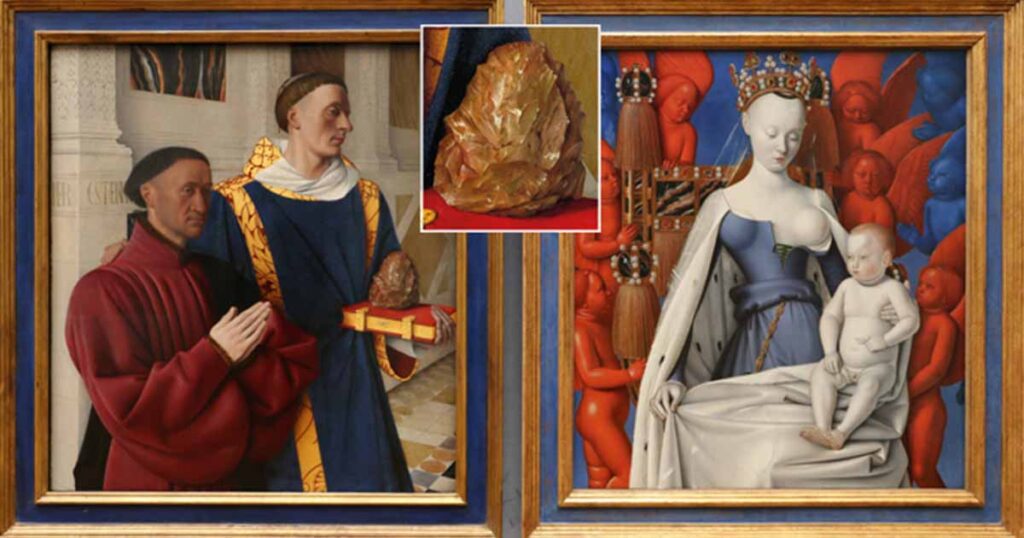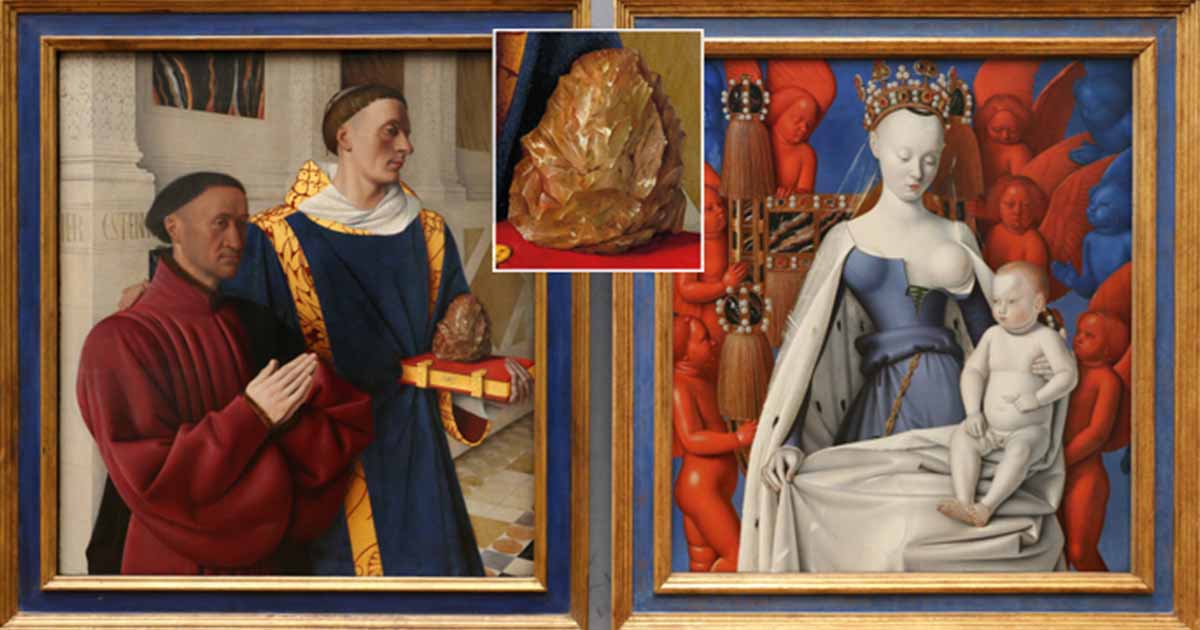

This artistic-anthropological mystery was solved after a team of researchers analyzed a curious stone, depicted in a 15th century French painting. Merging the Paleolithic Age with the Renaissance, the painted stone represents a prehistoric “Acheulean handaxe”.
Identifying the Anomalous Rock
Currently on display at the Gemäldegalerie in Berlin, Germany, “The Melun Diptych” was painted by Jean Fouquet around 1455 AD. The two colorful panels of this revered French Renaissance diptych feature the Virgin and Child surrounded by angels on the right, with Étienne Chevalier with Saint Stephen depicted on the left, with a large rock depicted on a red-bound copy of the New Testament.
Researchers from Dartmouth College and the University of Cambridge have published a study in the Cambridge Archaeological Journal, in which they suggest the stone object symbolizes “the death by stoning of Saint Stephen, the first Christian martyr.” Moreover, analysis of the rock has revealed that it represents “a prehistoric Acheulean handaxe”.

Jean Fouquet’s Étienne Chevalier with Saint Stephen, left panel of the Melun Diptych, painted c. 1455. Étienne Chevalier is in red, while Saint Stephen, in blue, accompanies him. The handaxe-like object (inset) rests upon a book and serves to identify Saint Stephen, who was stoned to death. (Yorck Project/Public Domain)
Evolution of the Acheulean Handaxe
Handaxes were first crafted by early hominins approximately 1.76 million years ago, during the Acheulean period, within the Lower Paleolithic [Early Stone Age]. Production technologies were developed over time, until the onset of the Middle Paleolithic, approximately 300,000 to 200,000 years ago.
Designed to assist hominins slicing meat, chopping wood, and digging into the earth for tubers, the Acheulean handaxe was generally made from flint/chert, and flaked on both sides with a pointed end. Anthropologically, the tool represents a hallmark of early human innovation and adaptability, and its distinct teardrop-shaped design reflects sophisticated cognitive abilities.

Handaxes, including a giant example discovered earlier this year. (( Archaeology South-East/ UCL )
Divine Thunder Bolts From Angry Gods
According to the new study, their research uncovered records from the mid-1500s revealing people at that time lacked any knowledge of ancient tools or the prehistoric societies that produced them. Medieval records referred to handaxes as “thunderstones shot from the clouds,” associating their teardrop shape and presence in the ground with this belief.
Over time, as archaeological and anthropological understanding advanced, these paranormal interpretations shifted, and during the 18th century Enlightenment, through increasing scientific understanding and archaeological discoveries, it was established that these rocks were in-fact handaxes, human-crafted tools from prehistoric times.

Close-up detail of the hand-axe like object in Jean Fouquet’s “Étienne Chevalier with Saint Stephen,” left panel of “The Melun Diptych” (circa 1455) by Jean Fouquet. (Yorck Project/Public Domain)
Reinterpreting Symbolic Medieval Art
In the painting, Chevalier prays wearing a crimson robe, while Saint Stephen, his patron, stands next to him with a copy of the New Testament in his hands. Atop the holy book, sits the stone object resembling a handaxe. Steven Kangas, a senior lecturer at Dartmouth’s Department of Art History, and a co-author of the new study, was the first to consider that the object looked just like a prehistoric Acheulean handaxe.
In an article provided by Dartmouth College, Kangas said he noticed the rock many years ago, but only in in 2021, after attending a seminar at Dartmouth about the Isimila site in Tanzania, which is famous for handaxes, did he make the connection between the artwork and the prehistoric tool.
Infra-Red Revealed An Under Drawing, And An Under Painting
To determine if the rock depicted in the painting was indeed intended to represent a prehistoric handaxe, three types of analyses were performed on the hypothesis. Firstly, an approach called Elliptical Fourier Analysis revealed the pear-shaped rock in the painting was similar, “within 95%,” of comparative Acheulean handaxes discovered in the region the artwork was painted. It was also demonstrated that the “33 flakes on the stone’s surface” match with the numbers of flakes on the surfaces of 30 handaxes samples from French assemblages.
The color of the painted rock was analyzed and compared to a sample set comprising 20 prehistoric French Acheulean handaxes. Accounting for glaze and wearing, it was found to be “very similar.” Finally, an Infrared Analysis revealed an underdrawing, and an underpainting, from which the stone object “had clearly been reworked,” according to the team.
The Earliest Artistic Depiction Of An Acheulean Handaxe On Record
The study concludes, that after artistic license is accounted for, it would appear that Fouquet painted an actual handaxe, that perhaps he had seen with his own eyes. Kangas wrote in the study that Fouquet spent a lot of time painting the stone, and this means he had “probably seen one that struck his attention and imagination”.
Co-author James Clark, a graduate student in the Department of Archaeology at the University of Cambridge, said Acheulean handaxes are not only one of “the longest-used tools,” but they also represent “the most investigated” of all Paleolithic artifacts. And he takes pride in announcing that this discovery, of a prehistoric tool depicted on a famous work of Renaissance art, presents “the earliest artistic depiction of an Acheulean handaxe,” on record.